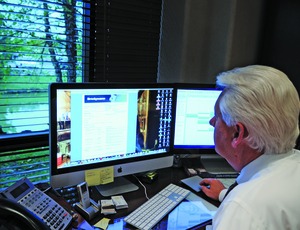

The iPad may be the hot tool for Gen Y managers at construction offices and jobsites, but its biggest devotee and chief software guru at Brinkmann Constructors is the Chesterfield, Mo., firm's white-haired CEO, Robert G. “Bob” Brinkmann, 62. Seeing a void in project management software that was efficient and affordable for midsize contractors, he led the firm's push to develop and market a new application that in-house boosters say is unique in the marketplace.
To test out and perfect the firm's Construction Superintendent-Journeyman app, Brinkmann tasked his stable of project managers and superintendents, most over 35 years old. But he also turned to an eager group of engineering students at the Missouri University of Science & Technology, Rolla, who find Brinkmann's app and donated iPads to be handy tools in their constructioncost-management class.
Brinkmann Constructors, an ENR Top 400 building contractor with $133 million in 2010 revenue, launched its app in July in a joint venture with developer Impact Technologies Inc. Bob Brinkmann says it is an alternative to low-end iPad construction apps—which are little more than “electronic pieces of paper”—and high-end software, tethered to a back-end operating system, that can cost users $70,000 or more in price and added fees.
Brinkmann's app, priced at about $300, automates and integrates data for key jobsite management functions, such as daily logs, safety inspections, work authorizations, requests for information (RFIs) and time sheets. Users also can create lists of vendors, subcontractors, equipment and project personnel and link data previously stored in multiple places.
The “due and pending” work-sheet feature reminds supers of upcoming and overdue forms. “We can't find any app that comes close to the level of detail and information this has,” says Brinkmann project director Ted K. Hoog.
Multiple Brinkmann managers tested the app for a few months before the launch and early October upgrade, says Bob Brinkmann. “Our guys took right to it,” he says. “All the forms that our staff needs are in one place, and you can carry it around on the jobsite.”
Brinkmann project superintendent Mark Lutz, 41, likens the app to “online banking for superintendents.” Completing daily logs takes half the time it used to, adds project super Greg Vossenkemper, 39, whose three children aided his iPad learning curve and now help him search for new apps. Adds Hoog, “We typically focus on subcontractors, tools and equipment but don't provide what may be today's most important source of time management for superintendents: proper technology.”
Brinkmann was anxious for construction students at the university, his alma mater, to use the software and build iPad proficiency, spending nearly $26,000 in company and peer-firm donations to buy 30 iPads and 30 app copies, says W. Eric Showalter, associate professor. Students now use the app and hardware rather than notebooks to keep construction project “diaries” for class discussion and ask questions with the RFI feature rather than e-mail.
“We've replaced the paper with the iPad, and I think it is a seamless transition,” he says. They also have access to the app's safety software, Apple spreadsheets and Skype, which are also on the hardware. “The app helps make the learning more real-world,” he says.
Showalter says posted PowerPoint slides can be downloaded easily. “Even if I make a change one minute before class, students can have the exact same slides as I am showing,” he says. Using other free software, Showalter and his students can annotate the slides. “This is new to me and the campus, so I have a discussion board set up for iPad apps,” Showalter adds. He says the university is testing how its information technology system handles “ubiquitous computing,” noting hurdles in licensing and other legal issues as well as concern about bandwidth sufficiency on campus.
Furthermore, Showalter will use iPads for next semester's senior design capstone course, which will include students from Missouri State University, Springfield, for the first time. “I will deploy at least two iPads to each team and expect students will 'Skype in' for team meetings,” he says. Having the devices in hand before class starts will allow students to rent digital textbooks. “I've only begun to think about the potential for teaching and learning,” says Showalter.
Brinkmann also is hopeful the new app will boost company efficiency and create a new profit center. Sales of the app have reached outside the U.S. to Canada, the U.K. and Brazil, says its CEO. “We've made a substantial investment,” he says. “Can we make a buck at this? We hope so.”





Post a comment to this article
Report Abusive Comment